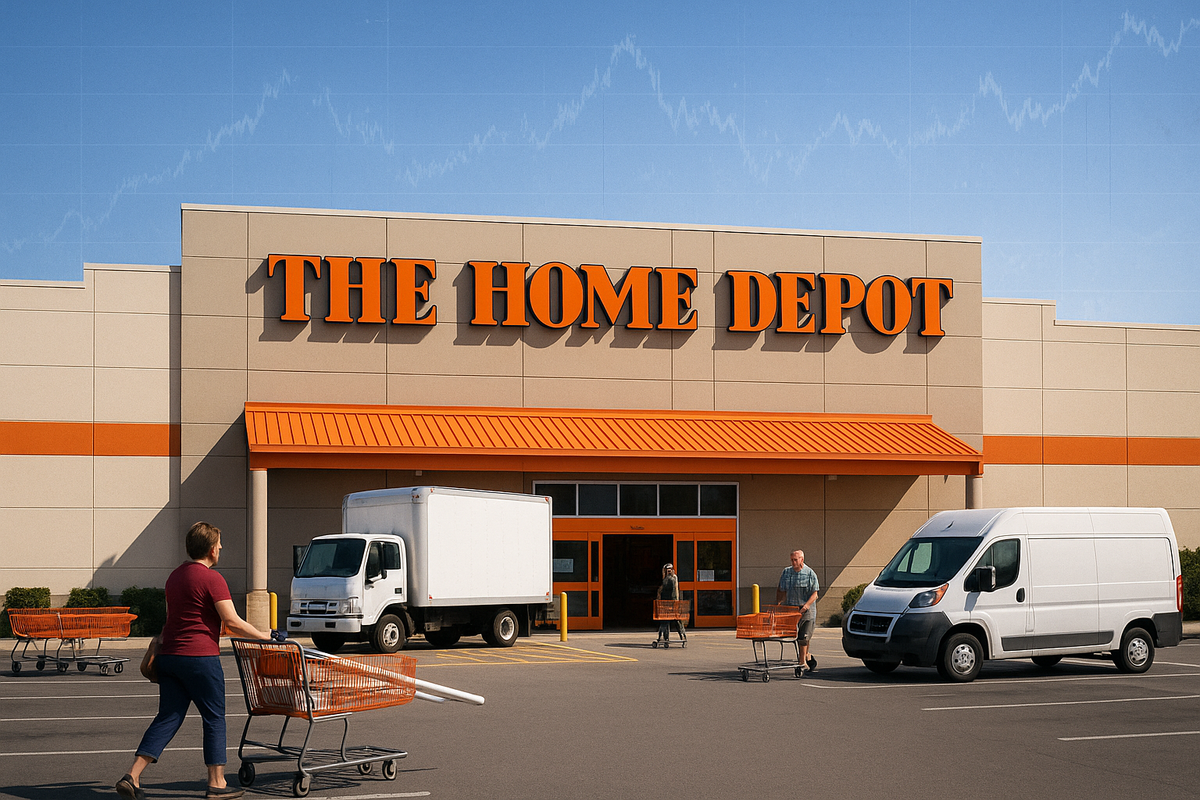
Home Depot (NYSE: HD), the nation's largest home improvement retailer, has found itself at a critical juncture, demonstrating resilience in its stock performance despite a recent quarterly showing that left some analysts underwhelmed. The company's strategic decision to uphold its annual guidance, coupled with its proactive stance on raising prices in response to escalating tariffs, has become a focal point for investors. This delicate balancing act between managing external economic pressures and reassuring the market about future profitability is shaping investor perception and setting a precedent for how major retailers might navigate a complex global trade environment.
Home Depot's Steady Hand: Navigating Tariffs and Tepid Earnings
Home Depot's recent financial disclosures revealed a mixed bag, with sales figures that, while robust, did not always meet the loftiest expectations of some market watchers. Despite this somewhat tepid quarterly performance, the company's leadership made a significant declaration: maintaining its full-year financial guidance. This commitment signals confidence in their underlying business model and their ability to weather potential economic headwinds. Crucially, the company also announced plans to implement price increases on certain goods, directly attributing this move to the impact of tariffs. This decision highlights the direct pass-through of trade policy costs to consumers, a trend that could become more prevalent across various sectors. The market's initial reaction saw Home Depot's stock hold relatively steady, suggesting that investors largely bought into the company's narrative of controlled management and strategic adaptation rather than viewing the tariff-induced price hikes as a sign of weakness.
Home Depot reported its second-quarter fiscal 2025 results on August 19, 2025, with total sales reaching $45.3 billion, a 4.9% increase year-over-year, though slightly missing analyst consensus estimates of around $45.5 billion. Net earnings were $4.6 billion, or $4.58 per diluted share, comparable to the previous year, while adjusted diluted earnings per share (EPS) of $4.68 fell just short of analyst expectations of $4.71-$4.72. Despite these slight misses, the company's stock (NYSE: HD) surged by approximately 4% to $410.50 in immediate reaction, indicating investor confidence in the company's long-term outlook and its ability to navigate current challenges.
The decision to maintain annual guidance for fiscal 2025, including approximately 2.8% total sales growth and 1.0% comparable sales growth, was a key factor in reassuring investors. CEO Ted Decker emphasized the continued momentum from the previous year, highlighting increased customer engagement in smaller home improvement projects and market share growth. Furthermore, Home Depot acknowledged the impact of escalating tariffs, with CFO Richard McPhail stating that "modest price movement" would occur in certain imported goods categories. This marks a shift from previous assurances of maintaining pricing, but the company stressed that over 50% of its products are domestically sourced, mitigating widespread price hikes. This transparent approach to managing tariff impacts, coupled with a focus on strategic sourcing and SKU-level analysis, appears to have resonated positively with the market.
Winners and Losers in the Tariff Tug-of-War
In the wake of Home Depot's strategic adjustments, the landscape of winners and losers in the retail and manufacturing sectors becomes clearer. Home Depot itself, by successfully maintaining investor confidence and demonstrating pricing power, emerges as a short-term winner. Its ability to pass on some tariff costs to consumers, albeit selectively, suggests a strong brand and customer loyalty that can absorb minor price increases without significant demand erosion. This strategy could serve as a blueprint for other large retailers with diversified supply chains and strong market positions.
However, the ripple effects extend beyond Home Depot. Manufacturers and suppliers heavily reliant on imported goods, particularly those with limited domestic production capabilities, could face significant pressure. These companies might be forced to absorb a larger portion of the tariff costs, impacting their profit margins, or risk losing business if their price increases are too steep for retailers like Home Depot to accept. Smaller retailers, lacking the scale and negotiating power of Home Depot, may also find themselves at a disadvantage. They might struggle to absorb tariff costs or pass them on to consumers, potentially leading to reduced competitiveness and market share.
Conversely, domestic manufacturers and suppliers stand to gain. As retailers seek to mitigate tariff impacts, there-shoring or increased sourcing from within the country becomes a more attractive option. This could lead to increased demand and production for U.S.-based companies, potentially boosting employment and investment in domestic manufacturing. Companies that have already diversified their supply chains away from heavily tariffed regions or those with strong domestic production capabilities will be better positioned to capitalize on this shift. Ultimately, the tariff environment creates a dynamic where agility, supply chain diversification, and strong market positioning become critical determinants of success.
Industry Impact and Broader Implications
Home Depot's response to tariffs and its steady guidance are not isolated events; they fit into a broader industry trend of retailers grappling with global trade uncertainties. The company's decision to selectively raise prices due to tariffs could set a precedent for other major retailers, signaling a shift from absorbing costs to passing them on to consumers. This move highlights the increasing pressure on supply chains and the potential for inflationary pressures to manifest in consumer goods. The broader implication is that consumers may increasingly bear the brunt of trade disputes, impacting their purchasing power and potentially influencing spending habits across various sectors.
The event also underscores the critical importance of supply chain resilience and diversification. Companies that have invested in robust, geographically diverse supply chains are better equipped to navigate trade disruptions and tariff impositions. This could lead to a long-term trend of de-globalization in certain manufacturing sectors, with companies prioritizing domestic or near-shore production to reduce exposure to geopolitical risks. Regulatory and policy implications are also significant. The ongoing tariff disputes highlight the need for clear and predictable trade policies to foster a stable business environment. Uncertainty in trade relations can deter investment and hinder long-term planning for businesses of all sizes. Historically, similar periods of trade protectionism have often led to increased domestic production but also higher consumer prices and potential retaliatory measures from trading partners. Home Depot's actions serve as a microcosm of how individual companies are adapting to these macro-level shifts, offering insights into the broader economic adjustments underway.
What Comes Next
In the short term, the market will closely watch how Home Depot's (NYSE: HD) modest price increases are received by consumers and whether they impact sales volumes. Any significant shift in consumer behavior due to these price adjustments could influence the company's future guidance and potentially lead to further strategic adaptations. Investors will also be keen to observe how other major retailers respond to similar tariff pressures. If Home Depot's strategy proves successful, it could encourage a broader trend of price adjustments across the retail sector, potentially contributing to broader inflationary trends.
Looking further ahead, the long-term implications are more profound. The ongoing trade tensions and the resulting tariff landscape could accelerate the trend of supply chain re-shoring or diversification. Companies may increasingly prioritize domestic or regional sourcing to mitigate risks associated with international trade disputes. This could create new market opportunities for domestic manufacturers and logistics providers, while simultaneously posing challenges for companies heavily reliant on overseas production. Furthermore, the situation could prompt a re-evaluation of global trade agreements and policies, with governments potentially seeking to establish more stable and predictable frameworks for international commerce. The resilience demonstrated by Home Depot in the face of these challenges will serve as a case study for how large corporations can adapt and thrive in an increasingly complex global economic environment.
Conclusion
Home Depot's recent performance and strategic decisions offer a compelling narrative of corporate resilience in the face of economic headwinds. Despite a somewhat subdued quarterly showing, the company's unwavering commitment to its annual guidance and its proactive approach to managing tariff impacts have largely reassured investors. This demonstrates the power of strong brand loyalty and operational efficiency in navigating challenging market conditions. The selective price increases, while a direct consequence of tariffs, also highlight the potential for consumers to bear some of the costs associated with global trade disputes.
Moving forward, the market will be closely monitoring several key indicators. Investors should pay attention to consumer spending patterns in response to potential price adjustments across the retail sector. The broader implications for supply chain diversification and the potential for increased domestic manufacturing will also be crucial to observe. Home Depot's ability to maintain its steady course amidst these complexities provides valuable insights into how large, established companies can adapt to evolving economic landscapes. The lasting impact of this period will likely be a renewed focus on supply chain resilience, strategic pricing, and agile business models as companies continue to navigate the intricate interplay of global trade, consumer demand, and economic policy.




